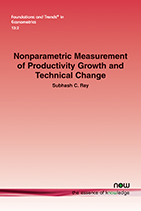Nonparametric Measurement of Productivity Growth and Technical Change
By Subhash C. Ray, University of Connecticut, USA, subhash.ray@uconn.edu
Abstract
The three main components of productivity change are technical change, change in technical efficiency, and returns to scale effects. Solow measured productivity change at the macroeconomic level as the difference between the growth rates of output and input which, under constant returns to scale and in the absence of any technical inefficiency, is a measure of technical change. The focus in this monograph is on the individual firm and both technical inefficiency and variable returns to scale are accommodated.
In neoclassical production economics, productivity change can be measured alternatively from the production, cost, profit, or distance functions. In continuous time analysis, one measures therates of productivity and technical change. In discrete time, one measuresindexes of productivity and technical change over time. This work describes the Tornqvist, Fisher, and Malmquist productivity indexes along with the Luenberger productivity indicator and a Geometric Young index and how they relate to one another. The relevant nonparametric DEA models for measuring the different productivity indexes are formulated for nonparametric analysis of productivity, technical change, and change in efficiency.
Nonparametric Measurement of Productivity Growth and Technical Change
Nonparametric Measurement of Productivity Growth and Technical Change explains how to isolate technical progress, scale effects, and efficiency changes as three distinct components of productivity change measured empirically using the nonparametric method of Data Envelopment Analysis (DEA). Section 2 provides a brief theoretical background, starting from the production possibility set, listing the basic assumptions about the reference technology, and defining the Shephard output and input distance functions, as well as technical change as shifts in the frontier of the production possibility set. Section 3 demonstrates how total factor productivity can be measured and decomposed into technical change, technical efficiency change, and scale effects using parametrically specified production, cost, profit, or distance functions. Section 4 explains the nonparametric method of DEA and formulates appropriate models for measuring input- or output-oriented technical efficiency, cost efficiency, and profit efficiency. Section 5 considers productivity change in discrete time. Section 6 explains the relationship between alternative productivity indexes and the Luenberger productivity indicator. Finally, Section 7 concludes with a summary and acknowledges several important topics related to the nonparametric measurement of productivity change not covered in this monograph, including the explicit accommodation of random noise in the DEA models, accounting for bad outputs, and the aggregation of firm-level measures of productivity change for comparison across groups.
